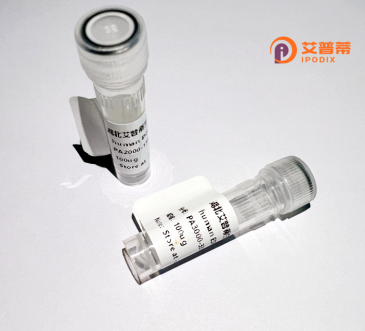
| 纯度 | >90%SDS-PAGE. |
| 种属 | Human |
| 靶点 | WDR19 |
| Uniprot No | Q8NEZ3 |
| 内毒素 | < 0.01EU/μg |
| 表达宿主 | E.coli |
| 表达区间 | 1-437 aa |
| 活性数据 | MKRIFSLLEKTWLGAPIQFAWQKTSGNYLAVTGADYIVKIFDRHGQKRSEINLPGNCVAMDWDKDGDVLAVIAEKSSCIYLWDANTNKTSQLDNGMRDQMSFLLWSKVGSFLAVGTVKGNLLIYNHQTSRKIPVLGKHTKRITCGCWNAENLLALGGEDKMITVSNQEGDTIRQTQVRSEPSNMQFFLMKMDDRTSAAESMISVVLGKKTLFFLNLNEPDNPADLEFQQDFGNIVCYNWYGDGRIMIGFSCGHFVVISTHTGELGQEIFQARNHKDNLTSIAVSQTLNKVATCGDNCIKIQDLVDLKDMYVILNLDEENKGLGTLSWTDDGQLLALSTQRGSLHVFLTKLPILGDACSTRIAYLTSLLEVTVANPVEGELPITVSVDVEPNFVAVGLYHLAVGMNNRAWFYVLGENAVKKIERYGVSGNSSQYLPSF |
| 分子量 | 75 kDa |
| 蛋白标签 | GST-tag at N-terminal |
| 缓冲液 | PBS, pH7.4, containing 0.01% SKL, 1mM DTT, 5% Trehalose and Proclin300. |
| 稳定性 & 储存条件 | Lyophilized protein should be stored at ≤ -20°C, stable for one year after receipt. Reconstituted protein solution can be stored at 2-8°C for 2-7 days. Aliquots of reconstituted samples are stable at ≤ -20°C for 3 months. |
| 复溶 | Always centrifuge tubes before opening.Do not mix by vortex or pipetting. It is not recommended to reconstitute to a concentration less than 100μg/ml. Dissolve the lyophilized protein in distilled water. Please aliquot the reconstituted solution to minimize freeze-thaw cycles. |
**1. "Mutations in WDR19 cause nephronophthisis and ciliary defects in zebrafish"**
**作者:** H. Oh et al.
**摘要:** 该研究通过基因测序发现WDR19突变与人类肾单位肾病相关,并在斑马鱼模型中证实其缺失导致纤毛结构和功能异常,表明WDR19在肾脏发育和纤毛形成中的关键作用。
**2. "WDR19 is a novel regulator of retrograde intraflagellar transport and Hedgehog signaling"**
**作者:** J. Wu et al.
**摘要:** 文中报道WDR19通过调控逆向鞭毛内运输(IFT)通路参与Hedgehog信号传导。重组人WDR19蛋白的体外实验表明其与IFT-A复合物相互作用,突变体导致纤毛信号传导障碍。
**3. "Functional characterization of WDR19 mutations associated with skeletal ciliopathies"**
**作者:** M. Schmidts et al.
**摘要:** 分析WDR19突变患者的临床数据,结合重组蛋白表达实验,揭示其突变导致纤毛组装缺陷及骨骼发育异常,如短肋胸廓发育不良综合征。
**4. "A role for WDR19 in maintaining the molecular composition of cilia"**
**作者:** E. Wheway et al.
**摘要:** 利用人源细胞系及重组WDR19蛋白研究,发现WDR19通过稳定纤毛膜蛋白的定位调控纤毛功能,其缺失引发多组织病变,包括肾脏和视网膜疾病。
这些文献涵盖WDR19在纤毛功能、遗传病机制及分子相互作用中的核心研究,提供重组蛋白的实验证据。
**Background of Human WD Repeat Domain 19 (WDR19) Protein**
WDR19. a member of the WD-repeat protein family, is characterized by its conserved β-propeller structure formed by repeating WD40 domains, which facilitate protein-protein interactions. It plays critical roles in diverse cellular processes, including ciliogenesis, cell cycle regulation, and intracellular trafficking. WDR19 is a component of the intraflagellar transport (IFT) complex, essential for the assembly and maintenance of primary cilia—a sensory organelle involved in signaling pathways like Hedgehog and Wnt. Dysfunction of WDR19 is linked to ciliopathies, such as Jeune syndrome, nephronophthisis, and retinal degeneration, reflecting its importance in tissue development and homeostasis.
As a recombinant protein, WDR19 is produced using expression systems (e.g., *E. coli* or mammalian cells*) to study its structure, interactions, and mechanisms. Recombinant WDR19 enables *in vitro* assays, structural analysis (e.g., crystallography), and screening for therapeutic compounds targeting ciliopathy-related pathways. Its study contributes to understanding diseases caused by ciliary defects and exploring potential interventions. Research continues to unravel its regulatory roles in cellular processes and its broader implications in human health.
×